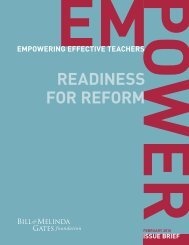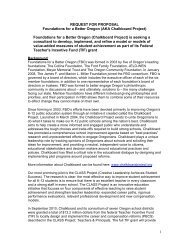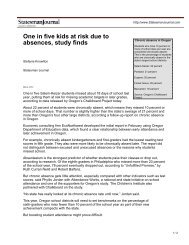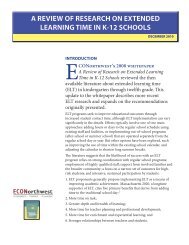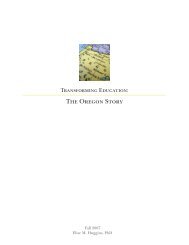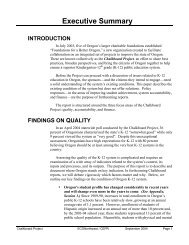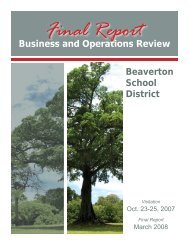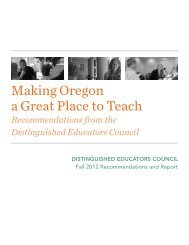Tapping the Potential - Alliance for Excellent Education
Tapping the Potential - Alliance for Excellent Education
Tapping the Potential - Alliance for Excellent Education
Create successful ePaper yourself
Turn your PDF publications into a flip-book with our unique Google optimized e-Paper software.
TA P P I N G T H E P O T E N T I A L : R E TA I N I N G A N D D E V E L O P I N G H I G H - Q U A L I T Y N E W T E A C H E R Ssupport new teachers or identify qualitymentors. Principals need training in <strong>the</strong>seareas if <strong>the</strong>y are to succeed.Un<strong>for</strong>tunately, principals often use poorcriteria to select teacher leaders, such ashow well <strong>the</strong>y manage noise in <strong>the</strong>irclassrooms or how well <strong>the</strong>y handle conflictswith parents.Principal leaders who foster positive,supportive environments and allow teachersgreater decisionmaking roles throughinduction can better hold on to newteachers and help <strong>the</strong>m become highqualityprofessionals. 93 Too often, teachersreport poor support from administratorsand lack of decisionmaking as reasons<strong>for</strong> leaving <strong>the</strong> profession. 94High-Quality ProvidersInduction can be run by multiple typesof providers as long as <strong>the</strong>y make <strong>the</strong>quality components available to everybeginning teacher. Schools have differentneeds that create demand <strong>for</strong> differentproviders. A range of providers couldinclude institutions of higher education,Cynthia Foster, PrincipalPonchatoula High SchoolCynthia Foster is <strong>the</strong> principal of Ponchatoula High School in Louisiana’s Tangipahoa Parish. To work well, both <strong>the</strong> parish induction program(Tangipahoa Framework <strong>for</strong> Inducting, Recruiting, and Sustaining Teachers—FIRST) and <strong>the</strong> statewide induction program (LouisianaTeacher Assistance and Assessment Program—LaTAAP) require strong principal leadership. Although state legislation specifies that mentors<strong>for</strong> new teachers be from <strong>the</strong> same discipline and grade level and that common planning time be established, <strong>the</strong> implementation of <strong>the</strong>seguidelines is left up to <strong>the</strong> individual principal. At Ponchatoula, Foster closely monitors <strong>the</strong> number and training of mentors so <strong>the</strong> school hasenough mentors, in each subject area, to work with new teachers. She ensures that mentors have a substitute teacher to cover <strong>the</strong>ir classeswhile <strong>the</strong>y conduct observations and meet with mentees. Foster is aware of available local and state training opportunities, and she regularlyencourages qualified teachers to take advantage of <strong>the</strong>m. Afterward, she asks newly trained teachers to share <strong>the</strong>ir skills with o<strong>the</strong>r teachers.Importantly, Foster recognizes her own limitations in inducting new teachers. She meets regularly with mentors to track <strong>the</strong>ir progress andsuggests ideas and resources to improve <strong>the</strong>ir work and <strong>the</strong> work of new teachers. Foster also promises to be a confidential source of support<strong>for</strong> new teachers, who are encouraged to come to her with problems or concerns.For more in<strong>for</strong>mation about Tangipahoa FIRST and LaTAAP, see Appendix A.Teachers <strong>for</strong> a New EraOne example of how to provide comprehensive induction is <strong>the</strong> clinical residency model used by <strong>the</strong> Carnegie Corporation of New York’sTeachers <strong>for</strong> a New Era (TNE). Begun in 2002, Teachers <strong>for</strong> a New Era aims to standardize university teacher education programs in <strong>the</strong> UnitedStates by enhancing eleven top-tier programs across <strong>the</strong> country.“At <strong>the</strong> conclusion of <strong>the</strong> project,” Carnegie <strong>for</strong>ecasts,“<strong>the</strong> selected institutionsshould be regarded by <strong>the</strong> nation as administering <strong>the</strong> best programs possible <strong>for</strong> <strong>the</strong> standard route to employment as a beginning professionalteacher.” 95 After completing coursework, graduates at TNE sites participate in two-year clinical residencies housed in local schoolsrun by a partnership of university faculty and school district personnel. Residencies develop new teachers’ skills in actual classrooms in practice-basedsettings. Residents are supported by university faculty and practicing teachers from <strong>the</strong> district. To make teacher education moreresponsive to local need, district teachers serve as clinical faculty at <strong>the</strong> participating university. At <strong>the</strong> same time, universities provide outsideprofessional support to TNE graduates.For more in<strong>for</strong>mation about Teachers <strong>for</strong> a New Era, see http://carnegie.org/sub/program/teachers.html.23



